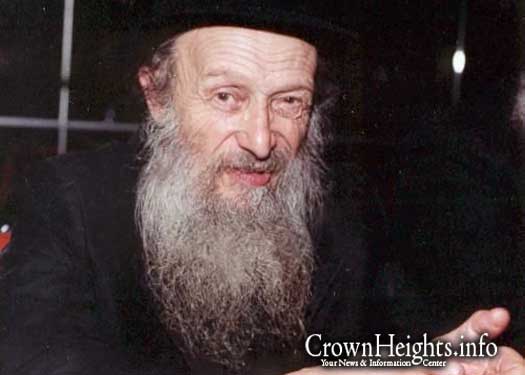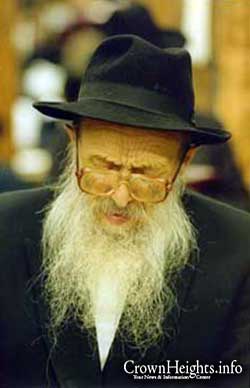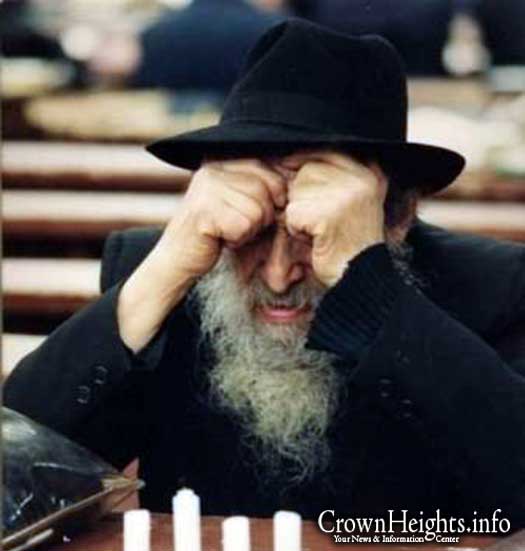
Our Heroes: Rabbi Michoel Teitelbaum (1912-2005)
Rabbi Michoel Teitelbaum, the person who opened Yeshiva Oholei Torah, was born in 1912, in Russia,. During his childhood, WWI broke out and followed by the Communist revolution when he literally began tasting msiras nefesh, and attained his Torah and Chassidus under difficult conditions. He studied a short while in Yeshivas Tomchei Tmimim in Nevel, with legendary figures in the group as Reb Mendel Futerfas and others. The Yeshiva was forced to close and the bochurim settled in Kremenshuk. There they created small underground cells in which they studied Torah and Chassidus. They had very little food, and slept, sometimes on a bench in a shul or in the park.
Reb Michoel was among the group that went to Vitebsk. They were unable to remain for too long. This was due to information that was disclosed to the KGB.
Opening Underground chadorim
Reb Michoel’s good friend, Reb Yisroel Yehuda Levin, described the events. “A letter was received from Reb Yehuda Eber that they were trying to obtain visas from Riga for fifteen bochurim, among whom was Reb Michoel. Rabbi Eber’s letter was written in code, but the KGB interrogator received the code from an older person, what the codes meant. The bochurim had to leave Vitebsk immediately. We were instructed that every bochur should travel with a friend to his native city where the two bochurim would be able to study Torah safely. I remained with Reb Michoel and we distributed money for the trip to the bochurim There were younger boys who cried, afraid that when they return home, they would be influenced negatively way, by their siblings, who were communists. Hearing them describe their feelings, we both failed pained and Reb Michoel could not hold back tears”.
Although Reb Michoel was young at the time, he was involved in organizing and conducting the underground Yeshivos. For example, an underground Chabad Yeshiva was opened and functioning in Kursk in 1933, and later a section for older bochurim was opened. They had originally studied in Kiev and were forced to move to Kursk, when the yeshiva closed. The Yeshiva in Kursk continued until 1935, then another division opened in Varaniz and Reb Michoel and his friends traveled there.
In the terrible 1930’s, we find Reb Michoel amongst the Tmimim in Malachovka. A Yeshiva had been opened there for Bochurim who had come from Gruzia, Georgia after their yeshiva had been closed down. The Yeshiva was situated in the local shul, more tranquil than other locations. Reb Yehuda Levin related further, that in Malachovka, Reb Shloma Chaim Kesselman taught chassidus. But the peace there did not last for long, and again the bochurim were forced to run from city to city in order to study, accompanied by fear, and pain from the extreme cold, and embarrassing hunger.
In 1935 through1936, the KGB strengthened their persecution of Jews. Reluctantly, the faculty of Tomchei Tmimim and its leader, Reb Yona Poltover, decided that older bochurim needed to open Yeshivos for younger bochurim.
The Smuggler
The responsibility of the older bochurim brought Reb Michoel to a height during the arrest of the children in Barditshov in 1938. Regarding details of this event, we quote from Reb Yechzekel Brod’s memoirs:
Orphan home
“We were brought to a government school for orphans. It was a nice place and it was obvious from the Mezuza markings and from a Suka, that Jews had once lived here. The children brought up in this institute were either orphans or that one parent was arrested and the second parent was not capable to take care of the child. The dean and most of the children were Jewish. These institutions such as this had been created by Stalin all over Russia, in order to brainwash children forcibly taken from political and religious families.
We were brought into a large dinning room, where we were addressed by the dean, ‘You are no longer in the domain of the KGB, but are free children. However, you will need to observe general rules of behavior’.
Over the course of time, we were ordered not to cover our heads and to eat everything that was served. The children did not cooperate with the authorities and therefore were transported to a different location which was also designated for orphans. Again, the children disregarded the rules.
It was Shvat of 1938, when the children visited the grave site of Reb Levi Yitzchok of Barditshov, where we prayed and cried, that we should be rescued from the hands of the these evil people. Usually, we would get permission to go for ice skating and then we would hide in the forest and put on Tefillin.
 Plans for an escape
Plans for an escape
Two of us received permission to go to the city. In the street, Bochurim met Reb Michoel Teitelbaum. His face was wrapped in bandages, to hide his beard but the two bochurim recognized him. He motioned to them that they should follow after him to the women’s section of the shul. Reb Michoel inquired about our condition and told us to work on a plan of escape.
He had just arrived from Zytomir, where there was a Chassidic community. Reb Mordechai Lazer in Zytomir, upon hearing about the children’s plight, said to Reb Michoel, ‘Whatever happens to us, we need to save the children’. They were horrified when they heard that we were among non-Jewish youths.
When Reb Michoel learned additional facts about the childrens’ situation, it increased in his mind the need to free us as quickly as possible. We began making plans to escape. The best day would be on Shabbos, when the dean was at home and security was much weaker.
On Shabbos, we went out for ice skating and asked permission to take a walk. In order not to raise suspicions we went out in groups of two, allowing a time lapse between each of the pairs. We met Reb Michoel at the pre arranged spot and he gave each of us a card for the train. Every pair of bochurim traveled to a different destination. All of the children reached their destinations safely. I stayed with my friend Reb Hershel Ceitlin at his aunt’s house in Homil”.
Yeshivos in Samarkand and Poking
WWII ushered a period of world confusion and strengthened the hunger in Russia. After a short period of time, a center was created in Samarkand, where a large group of Chassidim already lived, for Chabad Chassidim to take refuge. Reb Mendel Futerfas, Reb Abba Pliskin, Reb Michoel and other communal leaders set up the Yeshiva Tomchei Tmimim there. Funding of the yeshiva was an operation that took great efforts and unlimited devotion amid obvious danger with.
When the war ended, Reb Michoel was among the group of Anash who left Russia giving the appearance as Polish citizens that they were returning to their native country. In Poking Germany, where he went next Reb Michoel had a great share in setting up chadorim for the children of the refugees and preserving their authentic Chassidic chinuch, as he had in Vitebsk.
Years elapsed, and Reb Michoel arrived in the United States, where guided by the Rebbe’s directive, he obtained the position of shamesh in a Shul. He would encourage Jews to daven with a minyan, observe Shabbos and setting time for Torah study. Reb Michoel then lived then in the Bronx frequently on Shabbos and Yom Tov, he would walk Brooklyn, to participate in the Rebbe’s Farbrengens. Although he walked for many hours and sometimes in a difficult weather, Reb Michoel kept up this tradition. At the Farbrengen, he would try to hear the Rebbe’s Sichos and sometimes even lay under a table which was close to the Rebbe, in order to be able hear the Rebbe’s words.
Founding the Yeshiva Oholei Torah
The big turn in his life, which influenced thousands of children of Chabad Chasidim, took place in 1956. In the early years of the Rebbe’s nesius, the Rebbe took a strong stand against the American approach that integrated into religious and Chassidic circles, in which the concern for a child’s future demanded that children should also study English subjects, as well as Limudei Kodesh.
A group of Chassidim from Russia, who were already in New York, initiated the Rebbe’s call by planning an establishment of a Cheder which was based on a Chassidic chinuch without any secular studies.
Reb Yehuda Leib Mochkin and Reb Mendel Shemtov A”H, in addition to Reb Yisroel Duchman A”H, Reb Tzvi Hersh Chitrik and Reb Sholom Deitsch A”H and Reb Noson Gurary A”H, and Reb Dovid Deitsch, who adapted the Yeshiva as a “father” and remained the biggest supporter of Oholei Torah.
Behind the scene stood Reb Michoel, who was the moving spirit in creating the cheder which merited the name “Oholei Torah” and with the Rebbe’s Brochos took upon himself the yoke of conducting and supporting the institution. On the 19th of Teves in 1956 the Yeshiva was opened. In the first years of the Yeshiva, the Rebbe told Reb Michoel, “You will worry for the chinuch of the children and I will worry for the money”. The Rebbe encouraged Reb Michoel when all the additional levels of the yeshiva were added and established, from the kindergarten until the Bais Hamedrash, many years later. Every year, prior to the yeshiva dinner, the Rebbe would write a letter in which he would address and encourage the participants at the dinner to support this vital Yeshiva. The Rebbe also suggested that after the bochurim complete Bais Medrash, they should enter 770 as bochurim from all other Yeshivos.
With his passing, Rabbi Rosenfeld, the man who served from 1960, as the right hand of Reb Michoel, said, “Reb Michoel was first and foremost a true Chassidishe Yid. It is known the famous saying that a Chossid is one who knows how to be connected to the teachings of Chassidus, in a sense “Like this and not different”. This was Reb Michoel.
He began the yeshiva with three students in a shul in East Flatbush., the first teacher was the unforgettable mashpia, Reb Elye Chaim Roitblat, who was already a melamed in Samarkand.
Over the course of the years, the Yeshiva developed and grew from strength to strength, to the extent that the yeshiva reached the status of a beautiful institution that is incomparable. When looking back, it is no doubt that a central point in the heavenly success of the Yeshiva was in merit of the firmness and uncompromising stand of Reb Michoel. Actually, Reb Michoel did not have a specific title in the yeshiva, as mashgiach or mashpia. On the contrary, he headed the financial department. But his Chassidic image, his conduct and every expression of his, was a guide for every student. This reflected the Rebbe’s directive to Reb Michoel, “To supervise that the Chassidishkeit in Oholei Torah should be as it was in the past generations”.
The foundation on what the Yeshiva was founded, to study only limudei Kodesh and no secular studies, raised controversies. On one occasion, parents of students who were among the vital Yeshiva supporters went into the Rebbe’s room for Yechidus. They said they are very pleased with the chinuch in Oholei Torah but why shouldn’t the children learn a little English and a little math? The Rebbe responded, “Therefore you are pleased, because the child’s mind is not being confused with other matters, besides of learning Torah”.
‘Who granted you permission to inspect this institution?’
Indeed, the mere existence of this mosad is a miracle. According to the laws of the city and state, until the age of 16, there is a compulsory curriculum, in which the government is involved in implementing this curriculum. On one occasion, there was a notification of an inspection from the Education Department. Reb Michoel wrote to the Rebbe, and the Rebbe answered, “When the inspector comes, tell him very firmly, ‘Who granted you permission to inspect this institution?’ Reb Michoel followed the Rebbe’s advice and everything was cleared.
Legendary Chossid
Reb Michoel was a legendary Chossid. He would constantly recite Tanya and Mishnayos by heart. The Rebbe once instructed him that in addition to his recital of Mishanyos Kodshim, he should also include Mishanyos Taharos. He was always careful with doing of positive deeds and refraining from negative acts. His fear of Hashem was unique.
His bitul to the Rebbe was unusual. He once commented to someone, “What ever will be, this I will need to do. I already wrote to the Rebbe regarding this matter”. Anytime that Reb Michoel wrote about a certain project to the Rebbe, it was considered by him as receiving a directive from the Rebbe”.
In 2005, the Yeshiva was entering its fiftieth year, and painfully that this grand celebration took place without the presence of the Chossid who merited to conduct and develop the mosad.
During one of the Yechidusen, the Rebbe told Reb Michoel, “When Moshiach will come they will bring the Tzivos Hashem and say ‘See the children we brought up”.
Yehi Zichro Boruch! May Reb Michoel’s life serve as an inspiration of a legendary chossid, who in all times, under the KGB in Russia, or during WWII and other times, sacrificed himself in the upbringing of the young generation. He stood firmly in granting them the elite Chassidisher chinuch and thereby merited to see them becoming Shluchim, Rabonim and Chassidishe yidden that B”H influence communities over the world.
We should speedily witness “The ones who dwell in the dust will awaken and rejoice” with Reb Michoel amongst them.
















A general comment
When you post these heros – it would be appropriate to state at the end WHEN the Yartzeit actuality is